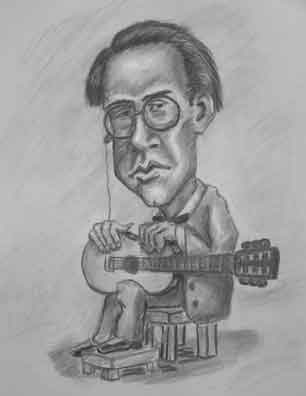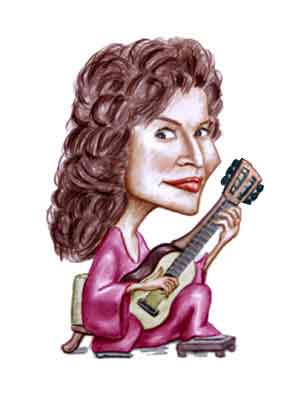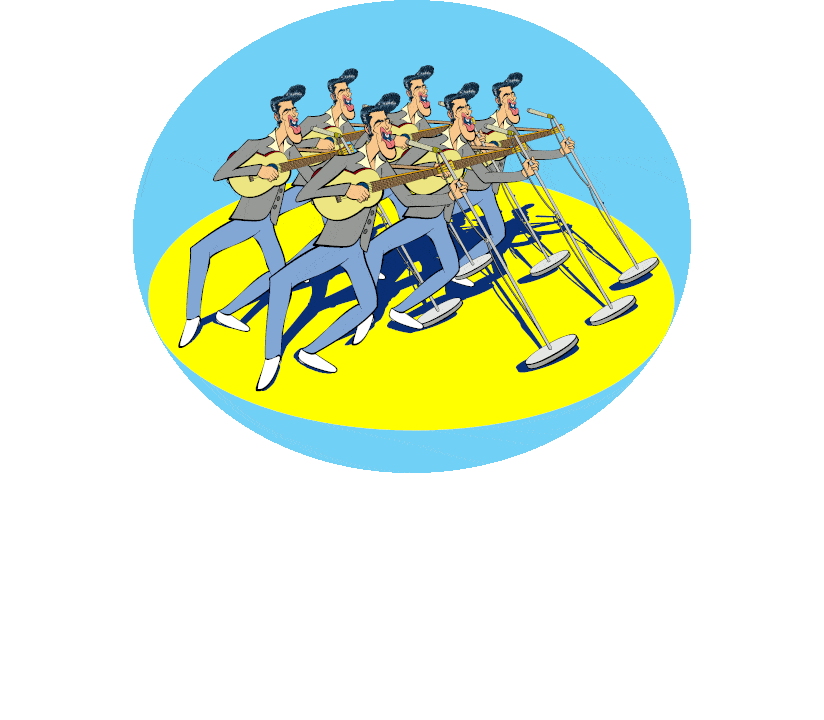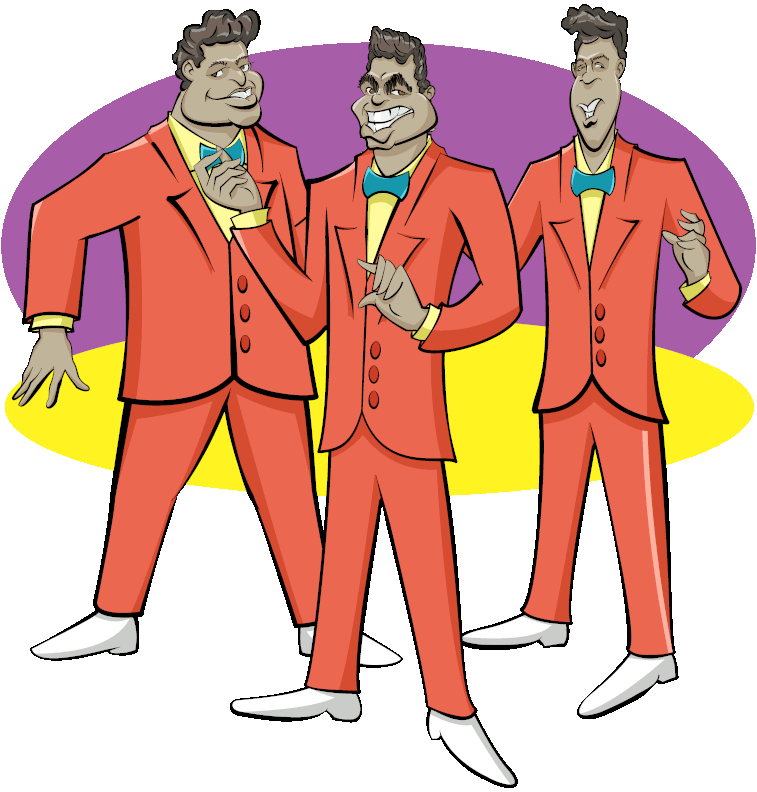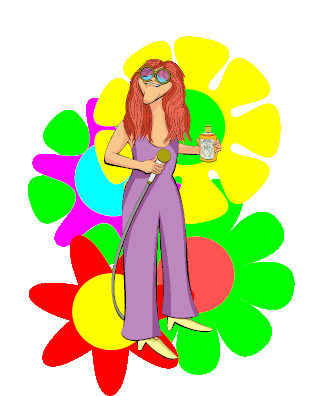Jimi Hendrix
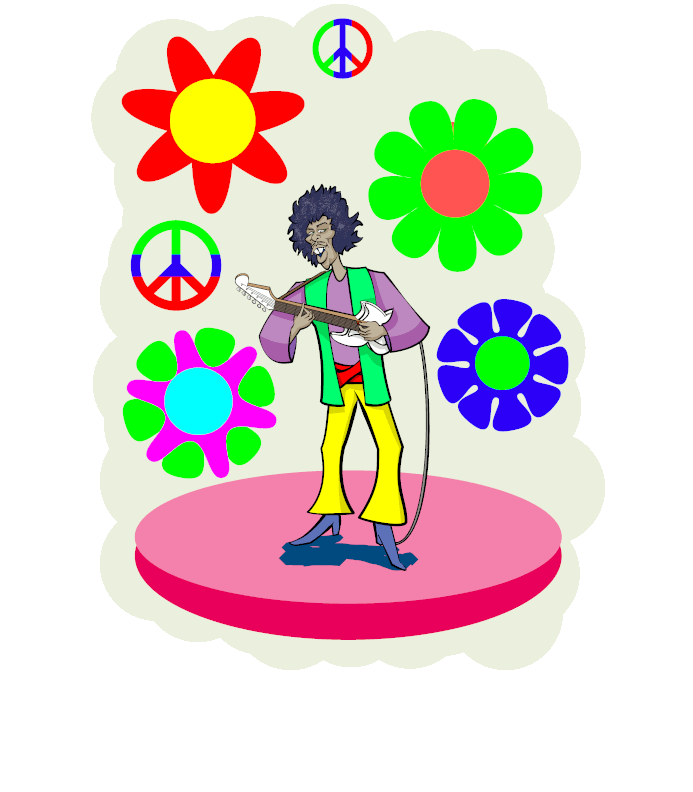
(Click on the image to zoom in.)
Jimi Hendrix was arguably  THE musician who ushered in the true electric sound of Rock Music. That is, his guitar playing actually required the technology of the solid body amplified guitar and was not just playing an acoustic guitar into a microphone.
THE musician who ushered in the true electric sound of Rock Music. That is, his guitar playing actually required the technology of the solid body amplified guitar and was not just playing an acoustic guitar into a microphone.
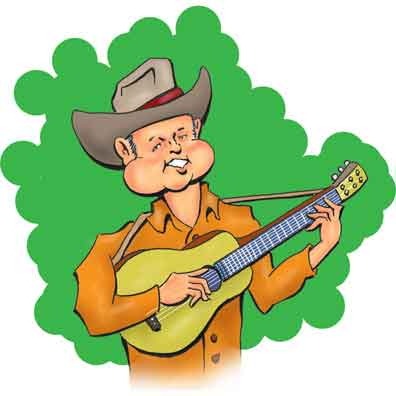
Merle Travis
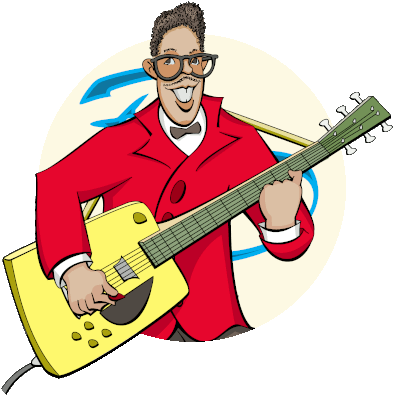
Bo Diddley

Les Paul and Mary Ford
Of course as Isaac Newton (sort of) said, geniuses stand on the shoulders of giants. George Beauchamp, Lloyd Loar, Adolf Rickenbacker, and Leo Fender were all inventors in the construction of amplified guitars, while musicians like Charlie Christian, Merle Travis, Bo Diddly, and of course the great Les Paul were also instrumental (no pun intended) in improving the design of the instrument as well as developing the playing techniques demanded by the electrified guitars.
Of course, traditional curmudgeons have decried the electrification of one of the most venerable instruments in history. They say that electric amplification of any kind distorts the sound and that the sweet tones of the instrument can only be appreciated in the recital hall without artificial enhancement.
Unfortunately, the sad truth is that if a large audience wants to hear a guitar, it has to be amplified, no if, ands, or buts. Although the great Andrés Segovia insisted that the unamplified classical guitar could be heard even in large auditoria, the audience did not always agree.
And that includes a knowledgeable audience. Guitarist Sharon Isbin, professor of guitar at Julliard, was once performing on a radio program and the host mentioned he had once gone to a concert and heard Andrés play.
"You actually heard him?" Sharon asked.
John Williams, one of the most accomplished classical guitarist of the later 20th century - and who played electric guitar as well - was even more explicit about what it was like attending an unamplified Segovia concert.
"Once you get past the magic of the great old man walking on the stage and all the history that goes with it, it was ridiculous, to be honest. You'd be sitting in the back of the festival hall, and you'd hear the odd little plink and plonk. It was magic but it wasn't music."
But Jimi's music. THAT you could hear.
Jimi would deliberately make the guitar sound shrill, discordant, piercing, and just plain loud. The means to this end was not just turning up the volume, but also was the controlled use of electronic feedback which is one of the ingredients that now defines the modern Rock sound.
Feedback is the loud and - to many - unpleasant squeal that you hear from the sound systems. It occurs when the microphone picks up its own sound coming from the speaker. Since the frequencies of the output and input are the same, you get positive reinforcement of the sound waves. So the music gets louder and louder.
However, amplifiers have a limit on the upper and lower volume. So at a certain loudness the top of the sound waves get chopped off and so no longer produce a smooth curve. Instead you have a series of abrupt up-and-down alternations in the increased air pressure and the following rarefactions. The result is sharp - and to some painful - sounds coming from the speakers.
Electric guitarists such as Jimi realized they could turn the annoying by-product into a part of the music. By controlling the amount of power sent to the amplifier (the gain) and how close the guitar is to the speaker, a skilled performer could control the amount of feedback. The result - together with accessories for fuzz, delay, and reverb - was a really wailing guitar.

Richie Havens
The Champion
(Click on the image to
zoom in and out.)
Jimi also had the technique for the new instrument. He had huge hands and with the narrow neck of the electric instrument, he could easily use his thumb to fret the bass strings, a method of playing suited to non-standard tunings and finger placements. This in itself wasn't entirely new as Merle Travis had been using the thumb-fretting in his own finger-picking style. And of course the champion of the thumb-fretters was the great Richie Havens.
But it was, we must admit, such sounds as Jimi made that helped fuel the famous Generation Gap. Despite some sage philosophers saying that generation gaps are ubiquitous throughout history, the Gap that arose between the generation populated by the fans of Les Paul and that which arose immediately after the Second World War was a gap that had no precedence in its intensity and duration.
Johnny - yes, he was born Johnny Allen Hendrix in 1942 in Seattle - had an extremely disrupted childhood. His father had been drafted into the army before he was born - there was, after all, a war on - and his mother found she couldn't look after an infant by herself and on a nearly null income.
So Johnny was taken care of by relatives, friends, neighbors, and sometimes even strangers. By the War's end, he was living in Los Angeles with a friend of his grandmother when his dad came down and took him back to Seattle. It was scary for a three year old to be taken in hand by a man whom he had never met and who later - for various reasons - legally changed his son's name to James Marshall Hendrix. So in Seattle he was no longer Johnny as he had always believed, but Jimmy. Not surprisingly, Jimmy later referred to his formative years as a time of confusion.
His mom and dad resumed life together but it was a fractious relationship - very fractious. Then in 1951, his mom suddenly moved out. Jimmy's relationship with his dad was strained but he did get along well with his younger brother, Leon (who called his big brother Buster). The two kids would deliberately misbehave because their "punishment" would be to spend the weekend with their mother. But their mom died when Jimmy was fifteen and his dad didn't think it a good idea for the kids to attend the funeral.
A turning point in Jimmy's life was in 1957 when he attended an Elvis Presley concert in the baseball park of the Seattle Rainiers. Jimi had first learned to play the ukulele and after sufficient pestering he got his dad to shuck out of five dollars to buy him a real acoustical guitar. But it was the electrified instrument in Elvis's show that grabbed his attention. Soon Jimi and his friends got their electrical guitars and were spending hours playing this new music called Rock and Roll.
Jimmy's progress was fast and still in his teens, he was able to join an actual band. Demand even for amateur musicians was high as this was a time when good music often had to be live music. Jimi and his friends would play at parties, dances, and of course, he would set up in the street and play for whatever the passers-by would toss his way. Jimmy dropped out of school in 1959 - not a surprise, considering - but rather than immediately try for a musical career, he joined the Army.
Jimmy fared well in the military and he qualified as a sharpshooter and then for paratrooper training. So he was dispatched to Kentucky to join the 101st Airborne. The big plus being in the army was that in his spare time he could still play his guitar. But then in a training jump he broke his ankle. A doctor said the ankle would never be strong enough for him to continue in the military and he was granted a medical discharge.
Jimmy decided to stay in the East, and he worked at odd jobs while continuing to pursue his music. Ultimately he moved to Nashville where he found work backing other groups and he became a semi-regular at a local club. He also toured with bands where the hours were long and the pay was low.
At the end of 1963 Jimmy decided that to get to the Big Time he had to get to the Big City. So he moved to New York which he found scary. But a good omen was that soon after his arrival he won an amateur music contest. The first prize was $25, a sum that was better money then than now.
But in what was Jimmy's first really BIG break, he was introduced to a trio of brothers from Detroit named Kelly, Ronnie, and Rudy Isley, as well as a gentleman from Georgia named Richard Wayne Penniman. Everyone called Richard "Little" although he was anything but. Jimmy toured with both the Isley's and Little Richard but his playing was a bit too distinctive and it drew attention away from the singers.
Jimmy had better luck when he began playing with saxophonist "King Curtis" Ousley. King was a mainstay for providing session music for the New York record companies. This provided regular work at fairly good pay. But at the time none of the executives who heard Jimmy rated him as star material.
Of course, business executives don't know everything, and by 1966 Jimmy had formed his own band. He and an ever-changing line-up called themselves Jimmy James and the Blue Flames. They mostly played the Greenwich Village clubs and were living - as he put it - on zero dollars a day.
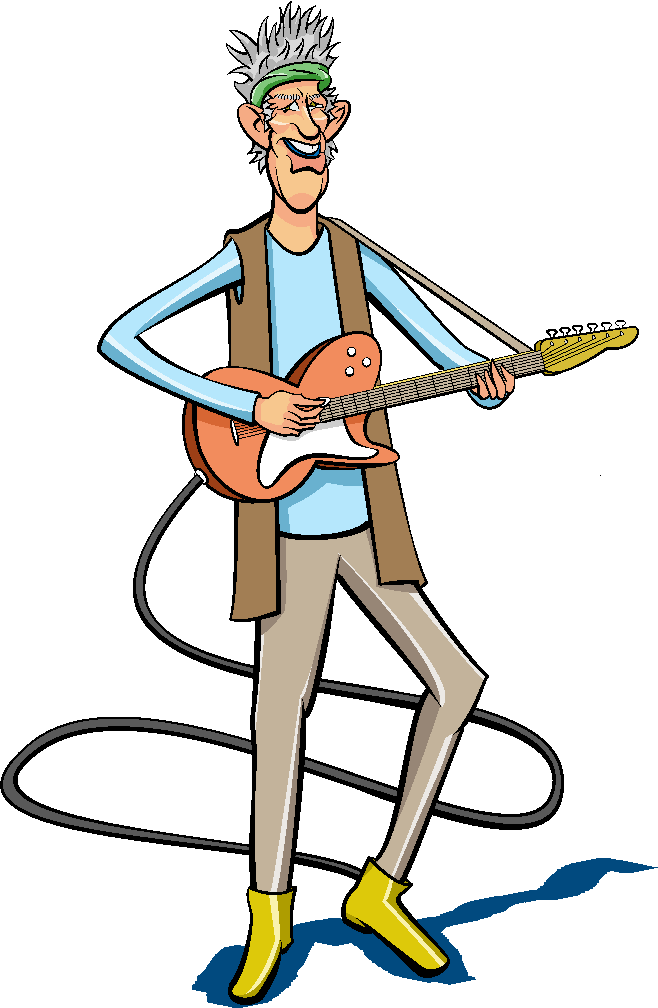
Keith Richards
(Click on the image to
zoom in and out.)
But then came Jimmy's REALLY BIG break. While playing the clubs, Jimmy met a young Englishwoman named Linda Keith, who just happened to be the girlfriend of guitarist Keith Richards. Keith, of course, was already famous as a member of the Rolling Stones. In fact, the Stones even showed up at one of Jimmy's shows and they were impressed.
It was through Linda that Jimmy met Chas Chandler who was the bass player for the English group The Animals. The Animals - whose lead singer was the strong singer Eric Burdon - had just found fame for their hard-rock version of the American folk tune "The House of the Rising Sun". But Chas had decided to stop performing and go into managing and producing, and he agreed to take Jimmy on as a client. As Chas was from England it was natural he would arrange for Jimmy to cross the Water. It was also at Chas's suggestion that Jimmy became Jimi.
Under Chas's guiding hand, Jimi along with bass guitarist Noel Redding and drummer Mitch Mitchell began touring the clubs in England and Europe as The Jimi Hendrix Experience. The clubs were well attended by other (and often big name) Rock musicians. They were as impressed with Jimi's playing as the Stones had been. But it wasn't just his playing, and it was in Europe that Jimi began to incorporate actions with his music - and unorthodox actions. After all, not many musicians would set fire to their guitars on stage.
Although Jimi had made a number of records in America none had done well and in England the band quickly cut two songs, "Hey Joe" and "Purple Haze". "Hey, Joe" didn't attract much attention, but the latter song became Jimmy's defining number. After selecting some additional songs, the resulting album Are You Experienced? rose to #2 on the UK charts. Jimi was a star.
Are You Experienced? did cross the Atlantic and reached #5. So it seemed this was the right time to return to the States, and in June 1967 Jimi appeared at the Monterey Pop Festival. There he was enthusiastically introduced by Brian Jones of the Rolling Stones and after the performance he "sacrificed" his guitar on stage.
But after this auspicious start, his first tour was as the opening act for - get this - the Monkees. That someone who even then was seen as a groundbreaking musician ended up second fiddle for a rock group that had started out as a fictitious plot point for a sit-com merits some explanation.
It's not true that The Monkees were not musicians and couldn't play their instruments. Peter Tork, Mike Nesmith, and Mickey Dolenz were capable guitarists. Davy Jones was a strong singer and had played the part of the Artful Dodger in the original London production of Oliver!. He also played the drums, but the producers had concerns that his small stature would be hidden behind the trap set, so Mickey took a crash course in drums and Davy became the lead singer. So the lineup for the show was established.
So Peter, Mike, Mickey, and Davy were not only real musicians but they were serious musicians. Mickey had in fact seen Jimi and his band at Monterey and had been impressed with his playing - not only with his virtuosity but how he would play the guitar with his teeth and then set it on fire. He thought action like that on stage would appeal to the Monkees' fans since the television show itself relied a lot on action. They spoke with Jimi and he thought it was a good idea.
It was a good theory, yes, but experimental data is what counts. The Monkee's fans included young teens and even pre-teens. So a lot of them went to the concerts accompanied by their parents. The parents, Mickey pointed, out were probably not too sanguine about having to attend a Monkees concert in the first place. And to have it opened by a band where the lead player and singer not only produced earsplitting and wailing cacophonies, plucked the strings with his teeth, set the guitar on fire, but also held the instrument as if he was paying it amatory attention - not the words Mickey used - was not a recipe for mainstream success.
And the kids had not come to see the Jimi Hendrix Experience. When Jimi came on stage and broke into "Purple Haze", the kids would immediately begin clamoring for the Monkees. Mickey also suspected that the parents were quick to raise a hue and cry with the city authorities about the crazy opening act and soon Jimi dropped out of the tour. But it didn't matter. Jimi was already being sent offers to perform and tour on his own.
Everyone knows how things turned out. By 1968, Jimi was one of the biggest names of Electric Rock. The album "Electric Ladyland" actually hit #1 in the US. But ironically given Jimi's iconicity, even today many of his songs are still not appreciated by mainstream audiences. Many of his releases did not break into the Top Ten, and in general his songs were more popular in England than in America.
Of course, Jimi's most famous performance was at Woodstock in 1969 where he played his electrified version of "The Star Spangled Banner". The song was never on the charts on its own but it was a track on the Woodstock motion picture soundtrack. The album was released in May 1970 and reached #1 on Billboard.
Sadly, Jimi's career lasted only four more months. He died on September 18, 1970 less than three weeks before Janis Joplin and of the same lamentable cause. Both were 27.
The sharp eyed viewer will note that Jimi holds his guitar a bit differently that most other virtuosi. In particular the tuning keys are on the bottom of the head which means Jimmy is in effect holding the instrument upside down. Guitarists immediately recognize this as indicating that Jimi was a southpaw - that is, a lefty.
Actually compared to many other devices devised in a right-handed world, guitars are easily adopted for the sinistromanual player. You simply string the instrument upside down so that when held left-handed, the bass strings will be on top and the treble strings are on the bottom just as for a right-handed player. Other famous left-handed guitarists are Slim Whitman, Albert King, Kurt Kobain, Malina Moye, and a chap named Sir Paul McCartney.
One more left-handed player that has to be mentioned is Elizabeth Cotton. Elizabeth was a folk singer and song writer and as she came from a very poor family she had to learn to play whatever guitar happened to be around. So she taught herself to play a right-handed instrument held upside down. That required her to pick the treble strings (and the melody) with her thumb while filling in the bass notes with her fingers. She played with a relaxed and pleasant style reminiscent of that of Mississippi John Hurt, and most listeners won't realize she is playing with any unorthodox technique. How Elizabeth became part of the 60's folk scene was also by a rather unorthodox route and is, as they say, another story.
References and Further Reading
Jimi Hendrix: The Man, The Magic, The Truth, Sharon Lawrence, Pan Books, 2005.
"How Jimi Hendrix’s Groundbreaking Techniques Are Still Influencing the Modern Rock, Blues and R&B Styles of Today’s Players", Andy Aledort, Guitar World, 2006.
"Who Really Invented the Electric Guitar?", Rich Maloof, Reverb, April 7, 2022.
"Jimi Hendrix Changed the Way the Guitar is Played", The Economist, December 14, 2016.
"How Did Jimi Hendrix Tune His Guitar?", Blues Guitar Guide, August 17, 2022.
"How Jimi Hendrix Set Rock'n'Roll Ablaze and Rewired the Electric Guitar Forever", Henry Yates, Louder Sound, June 21, 2021.
"Jimi Hendrix Guitars and Gear: A Comprehensive List", Taylor Petrie, Guitar Space, September 4, 2023.
I'm a Believer: My Life of Monkees, Music, and Madness, Micky Dolenz and Mark Bego, Hyperion, 1993.
"Elvis Presley Concert History", Concert Archives.
"John Williams", Interview with Mark Davis, Guitar Player Magazine, 2005.
"Jimi Hendrix Discography", Discogs.
